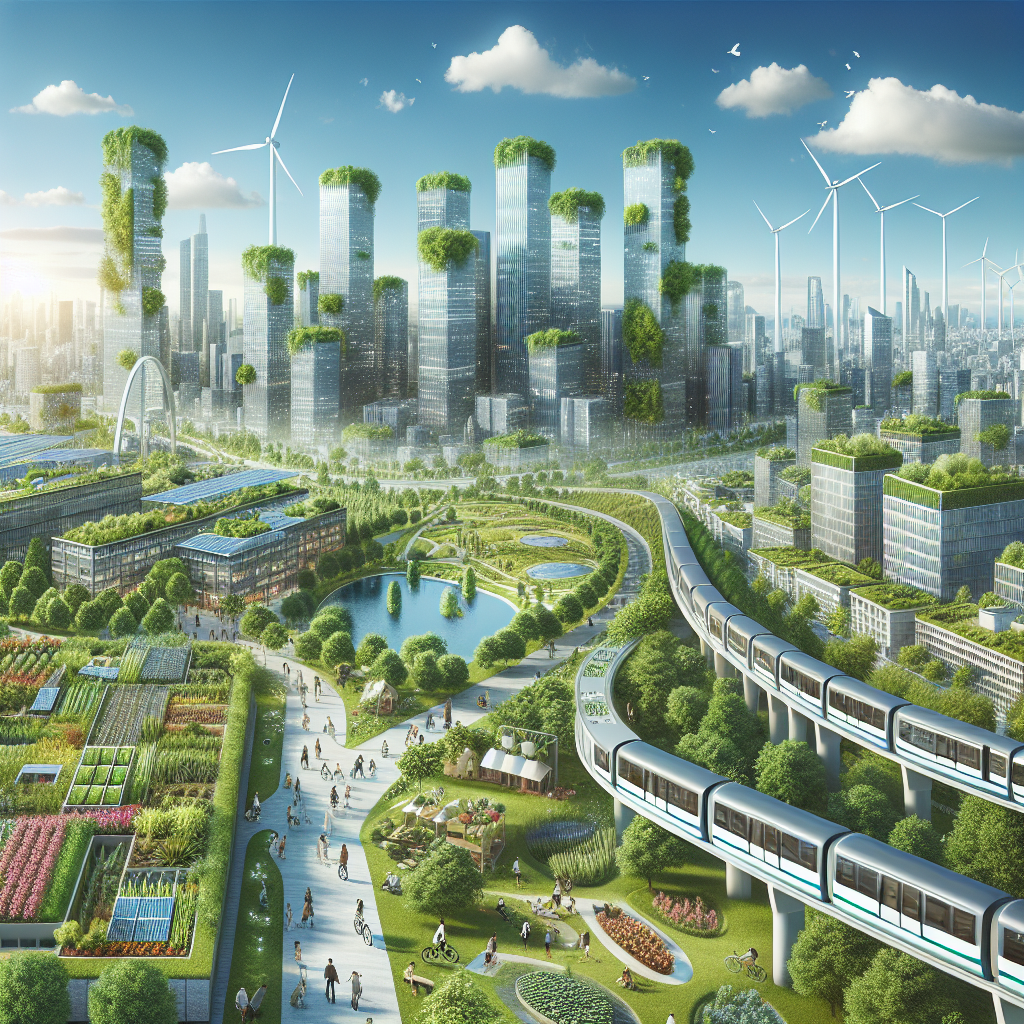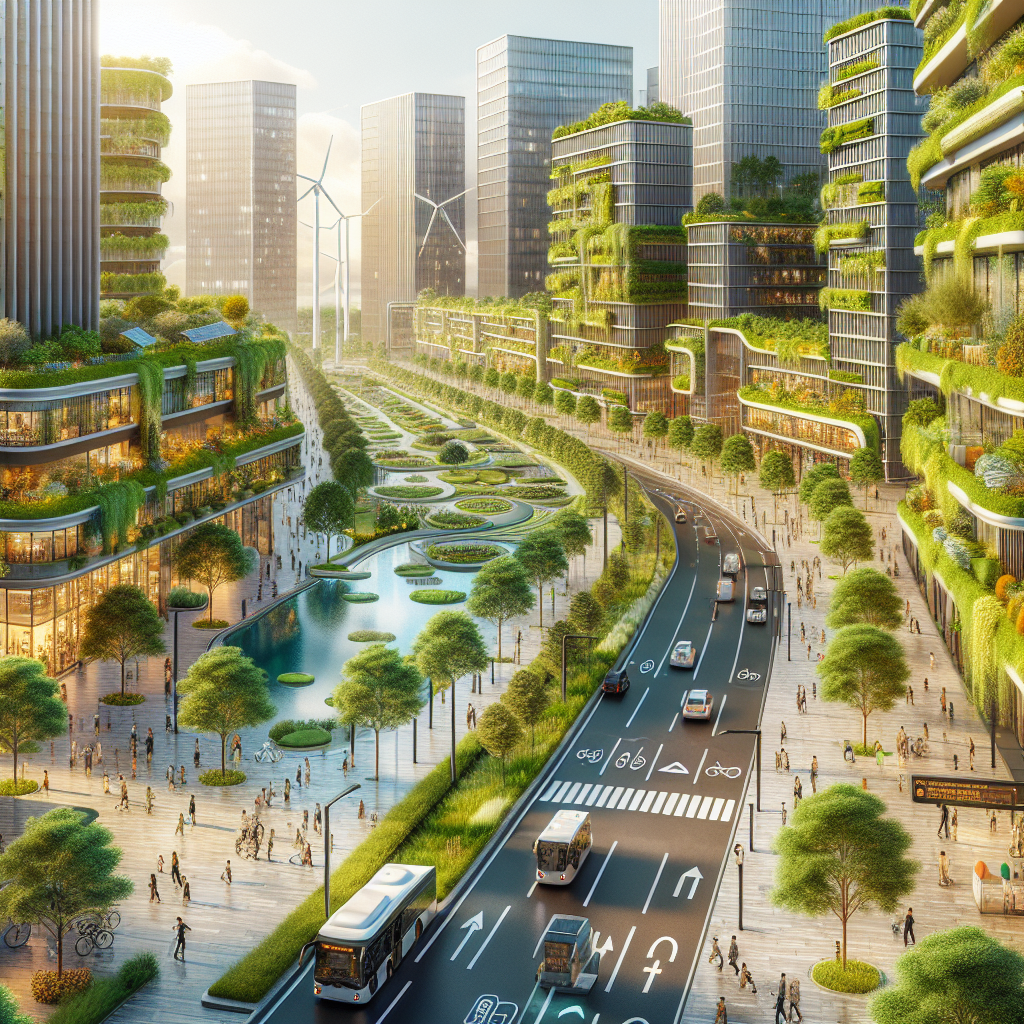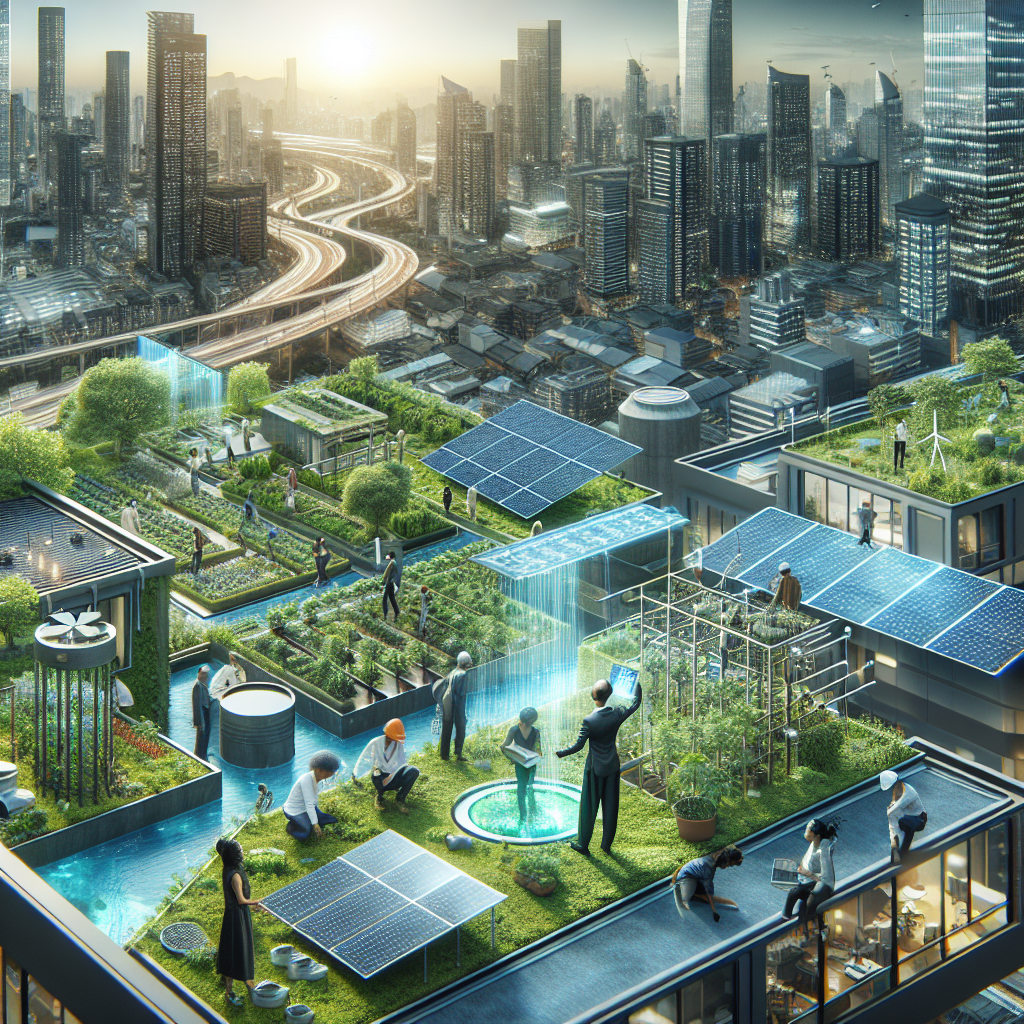In the wake of rapid urbanization, cities are increasingly turning towards green infrastructure projects to promote sustainable urban development. These initiatives aim to combat environmental degradation, enhance urban resilience, and improve the overall quality of life for residents. By integrating natural elements such as green roofs, rain gardens, and urban forests into the urban landscape, cities can effectively reduce air pollution, mitigate flood risks, and create healthier, more vibrant communities. This innovative approach to city planning not only benefits the environment but also contributes to economic growth and social well-being. Join us as we explore the exciting world of green infrastructure projects and their transformative impact on the sustainable development of our cities.
Understanding Green Infrastructure

– ### Definition of Green Infrastructure
Green infrastructure refers to a network of natural and semi-natural spaces, features, and systems that are strategically planned, designed, and managed to provide a range of ecosystem services. These services include but are not limited to stormwater management, air and water purification, climate regulation, biodiversity conservation, and recreational opportunities within urban environments. Unlike traditional gray infrastructure, green infrastructure utilizes living systems such as green roofs, rain gardens, permeable pavements, urban forests, and constructed wetlands to mimic natural processes in urban settings.
-
Importance of Green Infrastructure in Urban Areas
Green infrastructure plays a crucial role in enhancing the resilience and sustainability of urban areas by addressing various environmental, social, and economic challenges. Some key benefits of green infrastructure in urban settings include reducing the urban heat island effect, improving air and water quality, mitigating flood risks, enhancing biodiversity, promoting physical and mental well-being among residents, and fostering community engagement. By integrating green infrastructure into urban planning and development, cities can create more livable, healthy, and vibrant environments for their inhabitants while also contributing to climate change mitigation and adaptation efforts.
-
Examples of Green Infrastructure Projects
- Green Roofs: Green roofs involve the installation of vegetation on rooftops to enhance insulation, reduce energy consumption, capture stormwater runoff, and provide habitat for wildlife.
- Rain Gardens: Rain gardens are designed to capture and absorb rainwater from impervious surfaces, helping to reduce runoff, prevent flooding, and filter pollutants before they reach water bodies.
- Permeable Pavements: Permeable pavements allow rainwater to infiltrate through the surface, reducing runoff, replenishing groundwater supplies, and minimizing the risk of urban flooding.
- Urban Forests: Urban forests consist of trees, shrubs, and other vegetation strategically planted throughout cities to provide shade, improve air quality, sequester carbon, and enhance overall urban biodiversity.
- Constructed Wetlands: Constructed wetlands are engineered systems that mimic natural wetland ecosystems to treat wastewater, control stormwater, enhance water quality, and provide valuable habitat for diverse plant and animal species.
Benefits of Green Infrastructure Projects
Green infrastructure projects offer a wide array of benefits that contribute to the overall sustainable development of urban areas. These benefits can be categorized into environmental, social, and economic aspects.
-
Environmental Benefits
Green infrastructure projects play a crucial role in mitigating the impacts of climate change by reducing the urban heat island effect, improving air quality, and enhancing biodiversity. Green spaces such as parks, green roofs, and urban forests help absorb carbon dioxide, filter pollutants, and provide habitats for various species. By incorporating green infrastructure, cities can better manage stormwater, reduce flooding risks, and improve overall water quality.
-
Social Benefits
In addition to the environmental advantages, green infrastructure projects also offer significant social benefits. Access to green spaces within urban areas has been linked to improved mental health, reduced stress levels, and increased physical activity among residents. These projects create opportunities for community engagement, social interaction, and cultural activities, fostering a sense of belonging and well-being among urban dwellers. Furthermore, green infrastructure can enhance the overall aesthetics of a city, contributing to a more pleasant and livable environment for its residents.
-
Economic Benefits
From an economic perspective, investing in green infrastructure can lead to cost savings in the long run. By reducing energy consumption through the use of green roofs and green walls, cities can lower their operational costs and decrease the demand for traditional energy sources. Green infrastructure projects also have the potential to increase property values, attract businesses, and stimulate economic growth in urban areas. Additionally, the creation of green jobs in sectors such as landscaping, maintenance, and environmental consulting can further boost the local economy and create new employment opportunities.
Challenges in Implementing Green Infrastructure
- Funding Issues
Securing adequate funding is a major challenge in implementing green infrastructure projects for sustainable urban development. Many municipalities and organizations struggle to allocate sufficient financial resources to support the planning, design, and construction of green infrastructure initiatives. This lack of funding often results in delays or cancellations of projects, hindering progress towards creating more sustainable and resilient urban environments. Additionally, the long-term maintenance costs of green infrastructure can be a barrier, as ongoing funding is necessary to ensure the effectiveness and longevity of these projects.
- Lack of Awareness and Education
Another key challenge in implementing green infrastructure is the lack of awareness and education among stakeholders and the general public. Many people may not fully understand the benefits of green infrastructure or how it can contribute to sustainable urban development. This lack of awareness can lead to a lack of support for green infrastructure projects, making it difficult to garner the necessary resources and political will to move forward with implementation. Education and outreach efforts are crucial to increasing understanding and fostering community engagement in green infrastructure initiatives.
- Regulatory Barriers
Regulatory barriers present significant obstacles to the successful implementation of green infrastructure projects in urban areas. Local zoning laws, building codes, and other regulations may not always align with the goals of green infrastructure, making it challenging to incorporate these elements into urban planning and development. Overcoming regulatory barriers often requires collaboration between government agencies, policymakers, and community stakeholders to revise existing regulations or develop new policies that support the integration of green infrastructure into urban landscapes.

Successful Green Infrastructure Projects Around the World
-
High Line Park, New York City
The High Line Park in New York City is a prime example of successful green infrastructure revitalization. Built on a historic elevated railway line, this project transformed a disused urban space into a vibrant linear park. With a focus on sustainability, the park incorporates native plantings, green spaces, and innovative stormwater management systems. It has not only provided recreational opportunities for residents but also contributed to the economic development of the surrounding area.
-
Cheonggyecheon Stream Restoration, Seoul
The Cheonggyecheon Stream Restoration project in Seoul, South Korea, is a remarkable example of urban renewal through green infrastructure. By uncovering and restoring a buried stream that once flowed through the city, this project not only improved water quality but also enhanced the overall urban environment. The revitalization efforts included the creation of pedestrian-friendly walkways, green spaces, and natural habitats along the stream. This project has significantly boosted the city’s resilience to climate change and has become a popular recreational destination for residents and tourists alike.
-
The Green Roof Initiative, Basel

Basel, Switzerland, has been at the forefront of green infrastructure innovation with its Green Roof Initiative. This initiative promotes the installation of green roofs on buildings throughout the city to mitigate the urban heat island effect, reduce energy consumption, and improve air quality. By incorporating vegetation on rooftops, Basel has created additional green spaces, enhanced biodiversity, and reduced stormwater runoff. The Green Roof Initiative has not only improved the city’s environmental sustainability but has also inspired other urban areas to implement similar green infrastructure projects for sustainable development.
Future Trends in Green Infrastructure
In the realm of green infrastructure, future trends are shaping the way sustainable urban development projects are being planned and executed. These trends are critical in addressing environmental concerns and creating resilient cities for the future.
-
Integration of Technology
The integration of technology in green infrastructure projects is becoming increasingly prevalent. From the use of Geographic Information Systems (GIS) to analyze and map green spaces to the implementation of smart sensors for monitoring water quality in green infrastructure systems, technology is revolutionizing the way cities approach sustainability. The adoption of Building Information Modeling (BIM) software is also streamlining the design and construction processes of green infrastructure projects, allowing for more efficient and cost-effective solutions.
-
Collaboration between Stakeholders
Collaboration between stakeholders is essential for the success of green infrastructure projects. Municipalities, developers, community organizations, and environmental experts are coming together to pool resources, share knowledge, and work towards common sustainability goals. This collaborative approach ensures that green infrastructure projects are well-planned, inclusive, and supported by diverse perspectives. By engaging with a wide range of stakeholders, cities can address the complex challenges of urban sustainability in a holistic and effective manner.
-
Policy Changes to Support Green Infrastructure
Policy changes at the local, regional, and national levels are crucial for supporting green infrastructure initiatives. Governments are increasingly recognizing the importance of integrating nature-based solutions into urban planning and are enacting regulations to promote the development of green infrastructure. Incentive programs, such as tax breaks for green roofs or permeable pavement installations, are being implemented to encourage property owners to invest in sustainable infrastructure. Additionally, zoning laws are being updated to require the inclusion of green spaces in new developments, ensuring that cities prioritize environmental considerations in their urban planning efforts.
FAQs: Green Infrastructure Projects for Sustainable Urban Development
What are green infrastructure projects?
Green infrastructure projects refer to the implementation of eco-friendly initiatives and practices within urban areas to promote sustainable development. These projects typically involve the integration of natural elements such as green spaces, trees, and water features into the built environment to enhance environmental quality, mitigate climate change impacts, and improve overall community well-being.
How do green infrastructure projects contribute to sustainable urban development?
Green infrastructure projects contribute to sustainable urban development by addressing a range of environmental, social, and economic challenges. By incorporating green spaces and vegetation into urban design, these projects help to improve air and water quality, reduce urban heat island effects, enhance biodiversity, and promote public health and well-being. Additionally, green infrastructure projects can create job opportunities, boost property values, and attract investments in the community.
What are some examples of green infrastructure projects in urban areas?
Some common examples of green infrastructure projects in urban areas include the development of green roofs and walls, the construction of rain gardens and bioswales to manage stormwater, the restoration of urban wetlands and forests, the implementation of permeable pavement and bike lanes, and the creation of urban parks and green spaces. These projects are designed to help cities become more resilient, sustainable, and livable for residents.
How can communities get involved in green infrastructure projects?
Communities can get involved in green infrastructure projects by collaborating with local government agencies, non-profit organizations, and businesses to identify opportunities for implementing green initiatives within their neighborhoods. Residents can participate in public meetings, workshops, and volunteer events to provide input on project design and implementation, help maintain green infrastructure features, and advocate for policies that support sustainable urban development. By working together, communities can play a significant role in shaping the future of their cities through green infrastructure projects.
